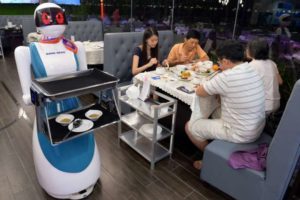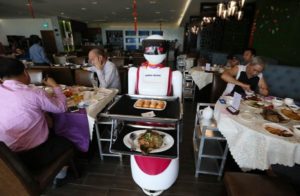Robots have helped several establishments in Singapore survive tight labor market.
Establishments and center offering services to the people found a big help from robots after the government imposed restrictions on hiring foreign workers.
In Singapore, restrictions on foreign workers have left many companies struggling to look for staff, pushing them to find means so that businesses will survive a tight labour market.
Service sector businesses — from restaurants to hospitals — robots are the answers in finding automated solutions to their workforce crunch.

Hospitals employed robots in order to help them monitor the patients condition.
Louis Tan, chief operating officer of Mount Elizabeth Novena hospital, said: “The government is clamping down on foreign workers — there is difficulty in hiring even skilled workers.
Technology has turned out to be one of the solutions.”
The said hospital is a private medical facility run by the Parkway Pantai group. Today, it is using the Watson technology of IBM as an automated “nurse” to monitor patients’ vital signs in the intensive care unit.
The robotic technology combines information from indicators in the patients body such as blood pressure and heart rate, and uses a predictive algorithm to calculate the risk of a patient’s condition getting worse.
He said: “It doesn’t mean nurses are absolved of responsibility. It just means they have another aid. It’s more efficient and safer for the patients.”
At Chilli Padi Nonya café, a restaurant near the National University of Singapore, dirty dishes are gathered by a robotic waiter that visits the tables chirping: “Could you help me to clear your table?”
The machine has no ability to pick up cups and plates itself, but the customers place their used dishes in a tray it carries back to the kitchen.

The restaurant’s manager, Kannan Thangaraj, said: “In Singapore it’s very difficult to get manpower from overseas, so it’s very helpful to get a robot. The customers are coming back because of the robot. They like to see it.”
Also in the said city-state, a research and development centre for MasterCard has made a design for the first payment application for SoftBank Robotics’ humanoid robot Pepper.
In this system, outlets of Pizza Hut in Asia will use the robot to take some customer orders and process card payments. It is a trial expected to take place before the year 2016 ends. The goal of this technology is to free waiters for more complex interactions with customers.
This budget, the government in Singapore has announced its plans to spend more than S$450m over the next three years to support the deployment of robots, aiming to provide affordable robotics to small and medium-sized enterprises operating in the city-state.
